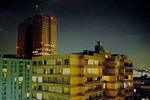Porte de la Villette station

Porte de la Villette (French pronunciation: [pɔʁt də la vilɛt]) is a station of the Paris Métro. The origin of the commune of the Villette was a Gallo-Roman village, which grew up on the Roman road that led to eastern Flanders. About 1198, it became Ville Neuve Saint-Ladre and by 1426 it was called Villette-Saint-Miser-lez-Paris. The commune became a part of Paris in 1860. The nearby gate in Paris' 19th century walls hence became known as the Porte de la Villette. The nearby Cité des Sciences et de l'Industrie, located in the Parc de la Villette, is the biggest science museum in Europe. The glass and steel building was designed by Peter Rice and it was opened in 1986. The station is featured in Battlefield 3, in which it is featured in a multiplayer map.
Excerpt from the Wikipedia article Porte de la Villette station (License: CC BY-SA 3.0, Authors, Images).Porte de la Villette station
Paris 19th Arrondissement (Paris)
Geographical coordinates (GPS) Address Nearby Places Show on map
Geographical coordinates (GPS)
| Latitude | Longitude |
|---|---|
| N 48.89709 ° | E 2.38588 ° |
Address
75019 Paris, 19th Arrondissement (Paris)
Ile-de-France, France
Open on Google Maps









